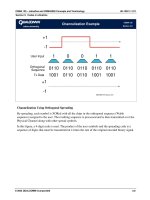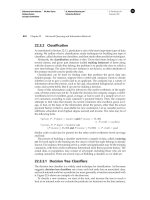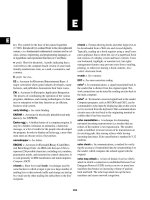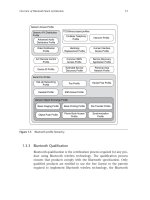Java Concepts 5th Edition phần 4 pptx
Bạn đang xem bản rút gọn của tài liệu. Xem và tải ngay bản đầy đủ của tài liệu tại đây (1.15 MB, 111 trang )
Java Concepts, 5th Edition
QUALITY TIP 6.1: Use for Loops for Their Intended
Purpose
A for loop is an idiom for a while loop of a particular form. A counter runs
from the start to the end, with a constant increment:
for (set counter to start; test whether counter at
end;
update counter by increment)
{ . . .
// counter, start, end, increment not changed here
}
If your loop doesn't match this pattern, don't use the for construction. The
compiler won't prevent you from writing idiotic for loops:
// Bad style-unrelated header expressions
for (System.out.println(“Inputs:”);
(x = in.nextDouble()) > 0;
sum = sum + x)
count++;
for (int i = 1; i <= years; i++)
{
// Bad style-modifies counter
if (balance >= targetBalance)
i = years + 1;
else
{
double interest = balance * rate / 100;
balance = balance + interest;
}
}
These loops will work, but they are plainly bad style. Use a while loop for
iterations that do not fit the for pattern.
241
Chapter 6 Iteration Page 19 of 82
Java Concepts, 5th Edition
COMMON ERROR 6.3: Forgetting a Semicolon
Occasionally all the work of a loop is already done in the loop header. Suppose
you ignored Quality Tip 6.1; then you could write an investment doubling loop as
follows:
for (years = 1;
(balance = balance + balance * rate / 100)
< targetBalance;
years++)
;
System.out.println(years);
The body of the for loop is completely empty, containing just one empty statement
terminated by a semicolon.
If you do run into a loop without a body, it is important that you make sure the
semicolon is not forgotten. If the semicolon is accidentally omitted, then the next
line becomes part of the loop statement!
for (years = 1;
(balance = balance + balance * rate / 100)
< targetBalance;
years++)
System.out.println(years);
You can avoid this error by using an empty block { } instead of an empty
statement.
COMMON ERROR 6.4: A Semicolon Too Many
What does the following loop print?
sum = 0;
for (i = 1; i <= 10; i++);
sum = sum + i;
System.out.println(sum);
Of course, this loop is supposed to compute 1 + 2 + … + 10 = 55. But actually, the
print statement prints 11!
241
242
Chapter 6 Iteration Page 20 of 82
Java Concepts, 5th Edition
Why 11? Have another look. Did you spot the semicolon at the end of the for
loop header? This loop is actually a loop with an empty body.
for (i = 1; i <= 10; i++)
;
The loop does nothing 10 times, and when it is finished, sum is still 0 and i is 11.
Then the statement
sum = sum + i;
is executed, and sum is 11. The statement was indented, which fools the human
reader. But the compiler pays no attention to indentation.
Of course, the semicolon at the end of the statement was a typing error. Someone's
fingers were so used to typing a semicolon at the end of every line that a semicolon
was added to the for loop by accident. The result was a loop with an empty body.
QUALITY TIP 6.2: Don't Use != to Test the End of a
Range
Here is a loop with a hidden danger:
for (i = 1; i != n; i++)
The test i != n is a poor idea. How does the loop behave if n happens to be zero
or negative?
The test i != n is never false, because i starts at 1 and increases with every step.
The remedy is simple. Use <= rather than != in the condition:
for (i = 1; i <= n; i++)
ADVANCED TOPIC 6.2: Variables Defined in a for Loop
Header
As mentioned, it is legal in Java to declare a variable in the header of a for loop.
Here is the most common form of this syntax:
242
243
Chapter 6 Iteration Page 21 of 82
Java Concepts, 5th Edition
for (int i = 1; i <= n; i++)
{
. . .
}
// i no longer defined here
The scope of the variable extends to the end of the for loop. Therefore, i is no
longer defined after the loop ends. If you need to use the value of the variable
beyond the end of the loop, then you need to define it outside the loop. In this loop,
you don't need the value of i—you know it is n + 1 when the loop is finished.
(Actually, that is not quite true—it is possible to break out of a loop before its end;
see Advanced Topic 6.4). When you have two or more exit conditions, though, you
may still need the variable. For example, consider the loop
for (i = 1; balance < targetBalance && i <= n; i++)
{
. . .
}
You want the balance to reach the target, but you are willing to wait only a certain
number of years. If the balance doubles sooner, you may want to know the value of
i. Therefore, in this case, it is not appropriate to define the variable in the loop
header.
Note that the variables named i in the following pair of for loops are
independent:
for (int i = 1; i <= 10; i++)
System.out.println(i * i);
for (int i = 1; i <= 10; i++) // Declares a new variable i
System.out.println(i * i * i);
In the loop header, you can declare multiple variables, as long as they are of the
same type, and you can include multiple update expressions, separated by commas:
for (int i = 0, j = 10; i <= 10; i++, j )
{
. . .
}
However, many people find it confusing if a for loop controls more than one
variable. I recommend that you not use this form of the for statement (see Quality
243
244
Chapter 6 Iteration Page 22 of 82
Java Concepts, 5th Edition
Tip 6.1). Instead, make the for loop control a single counter, and update the other
variable explicitly:
int j = 10;
for (int i = 0; i <= 10; i++)
{
. . .
j ;
}
6.3 Nested Loops
Sometimes, the body of a loop is again a loop. We say that the inner loop is nested
inside an outer loop. This happens often when you process two-dimensional
structures, such as tables.
Loops can be nested. A typical example of nested loops is printing a table with
rows and columns.
Let's look at an example that looks a bit more interesting than a table of numbers. We
want to generate the following triangular shape:
The basic idea is simple. We generate a sequence of rows:
for (int i = 1; i <= width; i++)
{
// Make triangle row
. . .
}
How do you make a triangle row? Use another loop to concatenate the squares [] for
that row. Then add a newline character at the end of the row. The ith row has i
symbols, so the loop counter goes from 1 to i.
Chapter 6 Iteration Page 23 of 82
Java Concepts, 5th Edition
for (int j = 1; j <= i; j++)
r = r + “[]”;
r = r + “\n”;
Putting both loops together yields two nested loops:
String r = “”;
for (int i = 1; i <= width; i++)
{
// Make triangle row
for (int j = 1; j <= i; j++)
r = r + “[]”;
r = r + “\n”;
}
return r;
Here is the complete program:
ch06/triangle1/Triangle.java
1 /**
2This class describes triangle objects that can be displayed
3as shapes like this:
4 []
5 [][]
6 [][][].
7*/
8 public class Triangle
9 {
10 /**
11Constructs a triangle.
12 @param aWidth the number of [] in the last row of the
triangle
13 */
14 public Triangle(int aWidth)
15 {
16 width = aWidth;
17 }
18
19 /**
20Computes a string representing the triangle.
21 @return a string consisting of [] and newline characters
244
245
Chapter 6 Iteration Page 24 of 82
Java Concepts, 5th Edition
22 */
23 public String toString()
24 {
25 String r = “”;
26 for (int i = 1; i <= width; i++)
27 {
28 // Make triangle row
29 for (int j = 1; j <= i; j++)
30 r = r + “[]”;
31 r = r + “\n”;
32 }
33 return r;
34 }
35
36 private int width;
37 }
ch06/triangle1/TriangleRunner.java
1 /**
2This program prints two triangles.
3 */
4 public class TriangleRunner
5 {
6 public static void main(String[] args)
7 {
8 Triangle small = new Triangle(3);
9 System.out.println(small.toString());
10
11 Triangle large = new Triangle(15);
12 System.out.println(large.toString());
13 }
14 }
245
246
Chapter 6 Iteration Page 25 of 82
Java Concepts, 5th Edition
Output
SELF CHECK
5. How would you modify the nested loops so that you print a square
instead of a triangle?
6. What is the value of n after the following nested loops?
int n = 0;
for (int i = 1; i <= 5; i++)
for (int j = 0; j < i; j++)
n = n + j;
6.4 Processing Sentinel Values
Suppose you want to process a set of values, for example a set of measurements. Your
goal is to analyze the data and display properties of the data set, such as the average
or the maximum value. You prompt the user for the first value, then the second value,
then the third, and so on. When does the input end?
One common method for indicating the end of a data set is a sentinel value, a value
that is not part of the data. Instead, the sentinel value indicates that the data has come
to an end.
246
247
Chapter 6 Iteration Page 26 of 82
Java Concepts, 5th Edition
Some programmers choose numbers such as 0 or −1 as sentinel values. But that is not
a good idea. These values may well be valid inputs. A better idea is to use an input
that is not a number, such as the letter Q. Here is a typical program run:
Enter value, Q to quit: 1
Enter value, Q to quit: 2
Enter value, Q to quit: 3
Enter value, Q to quit: 4
Enter value, Q to quit: Q
Average = 2.5
Maximum = 4.0
Of course, we need to read each input as a string, not a number. Once we have tested
that the input is not the letter Q, we convert the string into a number.
System.out.print(“Enter value, Q to quit: ”);
String input = in.next();
if (input.equalsIgnoreCase(“Q”))
We are done
else
{
double x = Double.parseDouble(input);
. . .
}
Now we have another problem. The test for loop termination occurs in the middle of
the loop, not at the top or the bottom. You must first try to read input before you can
test whether you have reached the end of input. In Java, there isn't a ready−made
control structure for the pattern “do work, then test, then do more work”. Therefore,
we use a combination of a while loop and a boolean variable.
Sometimes, the termination condition of a loop can only be evaluated in the middle
of a loop. You can introduce a Boolean variable to control such a loop.
boolean done = false;
while (!done)
{
Print prompt
String input = read input;
if (end of input indicated)
done = true;
Chapter 6 Iteration Page 27 of 82
Java Concepts, 5th Edition
else
{
Process input
}
}
This pattern is sometimes called “loop and a half”. Some programmers find it clumsy
to introduce a control variable for such a loop. Advanced Topic 6.3 shows several
alternatives.
Let's put together the data analysis program. To decouple the input handling from the
computation of the average and the maximum, we'll introduce a class DataSet. You
add values to a DataSet object with the add method. The getAverage method
returns the average of all added data and the getMaximum method returns the
largest.
ch06/dataset/DataAnalyzer.java
1 import java.util.Scanner;
2
3 /**
4This program computes the average and maximum of a set
5of input values.
6 */
7 public class DataAnalyzer
8 {
9 public static void main(String[] args)
10 {
11 Scanner in = new Scanner(System.in);
12 DataSet data = new DataSet();
13
14 boolean done = false;
15 while (!done)
16 {
17 System.out.print(“Enter value,
Q to quit: ”);
18 String input = in.next();
19 if
(input.equalsIgnoreCase(“Q”))
20 done = true;
21 else
22 {
247
248
Chapter 6 Iteration Page 28 of 82
Java Concepts, 5th Edition
23 double x =
Double.parseDouble(input);
24 data.add(x);
25 }
26 }
27
28 System.out.println(“Average = ” +
data.getAverage());
29 System.out.println(“Maximum = ” +
data.getMaximum());
30 }
31 }
ch06/dataset/DataSet.java
1 /**
2Computes information about a set of data values.
3 */
4 public class DataSet
5 {
6 /**
7Constructs an empty data set.
8 */
9 public DataSet()
10 {
11 sum = 0;
12 count = 0;
13 maximum = 0;
14 }
15
16 /**
17Adds a data value to the data set.
18 @param x a data value
19 */
20 public void add(double x)
21 {
22 sum = sum + x;
23 if (count == 0 || maximum < x)
maximum = x;
24 count++;
25 }
26
27 /**
248
249
Chapter 6 Iteration Page 29 of 82
Java Concepts, 5th Edition
28Gets the average of the added data.
29 @return the average or 0 if no data has been added
30 */
31 public double getAverage()
32 {
33 if (count == 0) return 0;
34 else return sum / count;
35 }
36
37 /**
38Gets the largest of the added data.
39 @return the maximum or 0 if no data has been
added
40 */
41 public double getMaximum()
42 {
43 return maximum;
44 }
45
46 private double sum;
47 private double maximum;
48 private int count;
49 }
Output
Enter value, Q to quit: 10
Enter value, Q to quit: 0
Enter value, Q to quit: -1
Enter value, Q to quit: Q
Average = 3.0
Maximum = 10.0
SELF CHECK
7. Why does the DataAnalyzer class call in.next and not
in.nextDouble?
8. Would the DataSet class still compute the correct maximum if you
simplified the update of the maximum field in the add method to the
following statement?
249
250
Chapter 6 Iteration Page 30 of 82
Java Concepts, 5th Edition
if (maximum < x) maximum = x;
HOW TO 6.1: Implementing Loops
You write a loop because your program needs to repeat an action multiple times.
As you have seen in this chapter, there are several loop types, and it isn't always
obvious how to structure loop statements. This How To walks you through the
thought process that is involved when programming a loop.
Step 1 List the work that needs to be done in every step of the loop body.
For example, suppose you need to read in input values in gallons and convert them
to liters until the end of input is reached. Then the operations are:
• Read input.
• Convert the input to liters.
• Print out the response.
Suppose you need to scan through the characters of a string and count the vowels.
Then the operations are:
• Get the next character.
• If it's a vowel, increase a counter.
Step 2 Find out how often the loop is repeated.
Typical answers might be:
• Ten times
• Once for each character in the string
• Until the end of input is reached
• While the balance is less than the target balance
If a loop is executed for a definite number of times, a for loop is usually
appropriate. The first two answers above lead to for loops, such as
Chapter 6 Iteration Page 31 of 82
Java Concepts, 5th Edition
for (int i = 1; i <= 10; i++) . . .
for (int i = 0; i < str.length(); i++) . . .
The next two need to be implemented as while loops—you don't know how
many times the loop body is going to be repeated.
Step 3 With a while loop, find out where you can determine that the loop is
finished.
There are three possibilities:
• Before entering the loop
• In the middle of the loop
• At the end of the loop
For example, if you execute a loop while the balance is less than the target
balance, you can check for that condition at the beginning of the loop. If the
balance is less than the target balance, you enter the loop. If not, you are done. In
such a case, your loop has the form
while (condition)
{
Do work
}
However, checking for input requires that you first read the input. That means,
you'll need to enter the loop, read the input, and then decide whether you want to
go any further. Then your loop has the form
boolean done = false;
while (!done)
{
Do the work needed to check the condition
if (condition)
done = true;
else
{
Do more work
}
}
250
251
Chapter 6 Iteration Page 32 of 82
Java Concepts, 5th Edition
This loop structure is sometimes called a “loop and a half”.
Finally, if you know whether you need to go on after you have gone through the
loop once, then you use a do/while loop:
do
{
Do work
}
while (condition)
However, these loops are very rare in practice.
Step 4 Implement the loop by putting the operations from Step 1 into the loop
body.
When you write a for loop, you usually use the loop index inside the loop body.
For example, “get the next character” is implemented as the statement
char ch = str.charAt(i);
Step 5 Double-check your variable initializations.
If you use a Boolean variable done, make sure it is initialized to false. If you
accumulate a result in a sum or count variable, make sure that you set it to 0
before entering the loop for the first time.
Step 6 Check for off-by-one errors.
Consider the simplest possible scenarios:
• If you read input, what happens if there is no input at all? Exactly one input?
• If you look through the characters of a string, what happens if the string is
empty? If it has one character in it?
• If you accumulate values until some target has been reached, what happens
if the target is 0? A negative value?
Manually walk through every instruction in the loop, including all initializations.
Carefully check all conditions, paying attention to the difference between
251
252
Chapter 6 Iteration Page 33 of 82
Java Concepts, 5th Edition
comparisons such as < and <=. Check that the loop is not traversed at all, or only
once, and that the final result is what you expect.
If you write a for loop, check to see whether your bounds should be symmetric or
asymmetric (see Quality Tip 6.3), and count the number of iterations (see Quality
Tip 6.4).
QUALITY TIP 6.3: Symmetric and Asymmetric Bounds
It is easy to write a loop with i going from 1 to n:
for (i = 1; i <= n; i++) . . .
The values for i are bounded by the relation 1≤i≤n. Because there
are≤comparisons on both bounds, the bounds are called symmetric.
When traversing the characters in a string, the bounds are asymmetric.
for (i = 0; i < str.length(); i++) . . .
The values for i are bounded by 0≤i < str.length(), with a≤comparison
to the left and a < comparison to the right. That is appropriate, because
str.length() is not a valid position.
Make a choice between symmetric and asymmetric loop bounds.
It is not a good idea to force symmetry artificially:
for (i = 0; i <= str.length() - 1; i++) . . .
That is more difficult to read and understand.
For every loop, consider which form is most natural for the problem, and use that.
QUALITY TIP 6.4: Count Iterations
Finding the correct lower and upper bounds for an iteration can be confusing.
Should I start at 0? Should I use <= b or < b as a termination condition?
Chapter 6 Iteration Page 34 of 82
Java Concepts, 5th Edition
Count the number of iterations to check that your for loop is correct.
Counting the number of iterations is a very useful device for better understanding a
loop. Counting is easier for loops with asymmetric bounds. The loop
for (i = a; i < b; i++) . . .
is executed b − a times. For example, the loop traversing the characters in a
string,
for (i = 0; i < str.length(); i++) . . .
runs str.length() times. That makes perfect sense, because there are
str.length() characters in a string.
The loop with symmetric bounds,
for (i = a; i <= b; i++)
is executed b − a + 1 times. That “+ 1” is the source of many programming
errors. For example,
for (n = 0; n <= 10; n++)
runs 11 times. Maybe that is what you want; if not, start at 1 or use < 10.
One way to visualize this “+ 1” error is to think of the posts and sections of a
fence. Suppose the fence has ten sections (=). How many posts (|) does it have?
|=|=|=|=|=|=|=|=|=|=|
A fence with ten sections has eleven posts. Each section has one post to the left,
and there is one more post after the last section. Forgetting to count the last
iteration of a “<=” loop is often called a “fence post error”.
If the increment is a value c other than 1, and c divides b − a, then the counts are
(b - a) / c for the asymmetric loop
(b - a) / c + 1 for the symmetric loop
252
253
Chapter 6 Iteration Page 35 of 82
Java Concepts, 5th Edition
For example, the loop for (i = 10; i <= 40; i += 5) executes (40 −
10)/5 + 1 = 7 times.
ADVANCED TOPIC 6.3: The “Loop and a Half” Problem
Reading input data sometimes requires a loop such as the following, which is
somewhat unsightly:
boolean done = false;
while (!done)
{
String input = in.next();
if (input.equalsIgnoreCase(“Q”))
done = true;
else
{
Process data
}
}
The true test for loop termination is in the middle of the loop, not at the top. This is
called a “loop and a half”, because one must go halfway into the loop before
knowing whether one needs to terminate.
Some programmers dislike the introduction of an additional Boolean variable for
loop control. Two Java language features can be used to alleviate the “loop and a
half” problem. I don't think either is a superior solution, but both approaches are
fairly common, so it is worth knowing about them when reading other people's
code.
You can combine an assignment and a test in the loop condition:
while (!(input = in.next()).equalsIgnoreCase(“Q”))
{
Process data
}
The expression
(input = in.next()).equalsIgnoreCase("Q")
253
254
Chapter 6 Iteration Page 36 of 82
Java Concepts, 5th Edition
means, “First call in.next(), then assign the result to input, then test whether
it equals “Q””. This is an expression with a side effect. The primary purpose of the
expression is to serve as a test for the while loop, but it also does some work—
namely, reading the input and storing it in the variable input. In general, it is a
bad idea to use side effects, because they make a program hard to read and
maintain. In this case, however, that practice is somewhat seductive, because it
eliminates the control variable done, which also makes the code hard to read and
maintain.
The other solution is to exit the loop from the middle, either by a return
statement or by a break statement (see Advanced Topic 6.4).
public void processInput(Scanner in)
{
while (true)
{
String input = in.next();
if (input.equalsIgnoreCase(“Q”))
return;
Process data
}
}
ADVANCED TOPIC 6.4: The break and continue
Statements
You already encountered the break statement in Advanced Topic 5.2, where it
was used to exit a switch statement. In addition to breaking out of a switch
statement, a break statement can also be used to exit a while, for, or do loop.
For example, the break statement in the following loop terminates the loop when
the end of input is reached.
while (true)
{
String input = in.next();
if (input.equalsIgnoreCase("Q"))
break;
double x = Double.parseDouble(input);
data.add(x);
}
254
Chapter 6 Iteration Page 37 of 82
Java Concepts, 5th Edition
In general, a break is a very poor way of exiting a loop. In 1990, a misused
break caused an AT&T 4ESS telephone switch to fail, and the failure propagated
through the entire U.S. network, rendering it nearly unusable for about nine hours.
A programmer had used a break to terminate an if statement. Unfortunately,
break cannot be used with if, so the program execution broke out of the
enclosing switch statement, skipping some variable initializations and running
into chaos [2, p. 38]. Using break statements also makes it difficult to use
correctness proof techniques (see Advanced Topic 6.5).
However, when faced with the bother of introducing a separate loop control
variable, some programmers find that break statements are beneficial in the
“loop and a half” case. This issue is often the topic of heated (and quite
unproductive) debate. In this book, we won't use the break statement, and we
leave it to you to decide whether you like to use it in your own programs.
In Java, there is a second form of the break statement that is used to break out of
a nested statement. The statement break label; immediately jumps to the end of
the statement that is tagged with a label. Any statement (including if and block
statements) can be tagged with a label—the syntax is
label: statement
The labeled break statement was invented to break out of a set of nested loops.
outerloop:
while (outer loop condition)
{ . . .
while (inner loop condition)
{ . . .
if (something really bad happened)
break outerloop;
}
}
Jumps here if something really bad happened
Naturally, this situation is quite rare. We recommend that you try to introduce
additional methods instead of using complicated nested loops.
254
255
Chapter 6 Iteration Page 38 of 82
Java Concepts, 5th Edition
Finally, there is another goto− like statement, the continue statement, which
jumps to the end of the current iteration of the loop. Here is a possible use for this
statement:
while (!done)
{
String input = in.next();
if (input.equalsIgnoreCase("Q"))
{
done = true;
continue; // Jump to the end of the loop body
}
double x = Double.parseDouble(input);
data.add(x);
// continue statement jumps here
}
By using the continue statement, you don't need to place the remainder of the
loop code inside an else clause. This is a minor benefit. Few programmers use
this statement.
6.5 Random Numbers and Simulations
In a simulation you generate random events and evaluate their outcomes. Here is a
typical problem that can be decided by running a simulation: the Buffon needle
experiment, devised by Comte Georges− Louis Leclerc de Buffon (1707–1788), a
French naturalist. On each try, a one−inch long needle is dropped onto paper that is
ruled with lines 2 inches apart. If the needle drops onto a line, count it as a hit. (See
Figure 3.) Buffon conjectured that the quotient tries/hits approximates π.
In a simulation, you repeatedly generate random numbers and use them to simulate
an activity.
Now, how can you run this experiment in the computer? You don't actually want to
build a robot that drops needles on paper. The Random class of the Java library
implements a random number generator, which produces numbers that appear to be
completely random. To generate random numbers, you construct an object of the
Random class, and then apply one of the following methods:
255
256
Chapter 6 Iteration Page 39 of 82
Java Concepts, 5th Edition
Method Returns
nextInt(n) A random integer between the integers 0 (inclusive) and n
(exclusive)
nextDouble() A random floating−point number between 0) (inclusive) and 1
(exclusive)
For example, you can simulate the cast of a die as follows:
Random generator = new Random();
int d = 1 + generator.nextInt(6);
The call generator.nextInt(6) gives you a random number between 0 and 5
(inclusive). Add 1 to obtain a number between 1 and 6.
To give you a feeling for the random numbers, run the following program a few times.
Figure 3
The Buffon Needle Experiment
ch06/random1/Die.java
1 import java.util.Random;
2
3 /**
4This class models a die that, when cast, lands on a random
5face.
6 */
7 public class Die
8 {
9 /**
10Constructs a die with a given number of sides.
256
257
Chapter 6 Iteration Page 40 of 82
Java Concepts, 5th Edition
11 @param s the number of sides, e.g., 6 for a normal die
12 */
13 public Die(int s)
14 {
15 sides = s;
16 generator = new Random();
17 }
18
19 /**
20Simulates a throw of the die.
21 @return the face of the die
22 */
23 public int cast()
24 {
25 return 1 + generator.nextInt(sides);
26 }
27
28 private Random generator;
29 private int sides;
30 }
ch06/random1/DieSimulator.java
1 /**
2This program simulates casting a die ten times.
3 */
4 public class DieSimulator
5 {
6 public static void main(String[] args)
7 {
8 Die d = new Die(6);
9 final int TRIES = 10;
10 for (int i = 1; i <= TRIES; i++)
11 {
12 int n = d.cast();
13 System.out.print(n + “ ”);
14 }
15 System.out.println();
16 }
17 }
257
Chapter 6 Iteration Page 41 of 82
Java Concepts, 5th Edition
Typical Output
6 5 6 3 2 6 3 4 4 1
Typical Output (Second Run)
3 2 2 1 6 5 3 4 1 2
As you can see, this program produces a different stream of simulated die casts every
time it is run.
Actually, the numbers are not completely random. They are drawn from very long
sequences of numbers that don't repeat for a long time. These sequences are computed
from fairly simple formulas; they just behave like random numbers. For that reason,
they are often called pseudorandom numbers. Generating good sequences of numbers
that behave like truly random sequences is an important and well−studied problem in
computer science. We won't investigate this issue further, though; we'll just use the
random numbers produced by the Random class.
To run the Buffon needle experiment, we have to work a little harder. When you
throw a die, it has to come up with one of six faces. When throwing a needle,
however, there are many possible outcomes. You must generate two random numbers:
one to describe the starting position and one to describe the angle of the needle with
the x−axis. Then you need to test whether the needle touches a grid line. Stop after
10,000 tries.
Let us agree to generate the lower point of the needle. Its x−coordinate is irrelevant,
and you may assume its y − coordinate y
low
to be any random number between 0 and
2. However, because it can be a random floating−point number, we use the
nextDouble method of the Random class. It returns a random floating − point
number between 0 and 1. Multiply by 2 to get a random number between 0 and 2.
The angle α between the needle and the x−axis can be any value between 0 degrees
and 180 degrees. The upper end of the needle has y−coordinate
= + sin ( α)y
high
y
low
The needle is a hit if y
high
is at least 2. See Figure 4.
257
258
Chapter 6 Iteration Page 42 of 82
Java Concepts, 5th Edition
Figure 4
When Does the Needle Fall on a Line?
Here is the program to carry out the simulation of the needle experiment.
ch06/random2/Needle.java
1 import java.util.Random;
2
3 /**
4This class simulates a needle in the Buffon needle experiment.
5 */
6 public class Needle
7 {
8 /**
9Constructs a needle.
10 */
11 public Needle()
12 {
13 hits = 0;
14 tries = 0;
15 generator = new Random();
16 }
17
18 /**
19Drops the needle on the grid of lines and
20 remembers whether the needle hit a
line.
258
259
Chapter 6 Iteration Page 43 of 82









